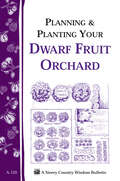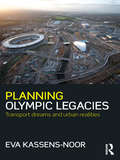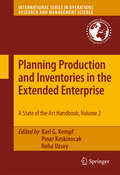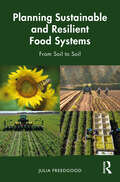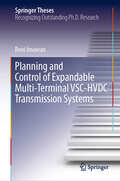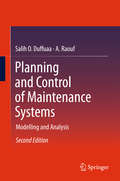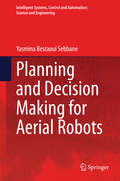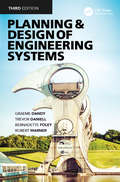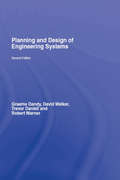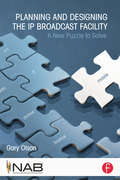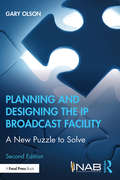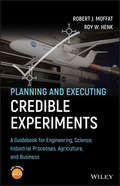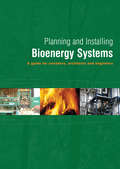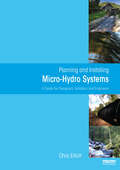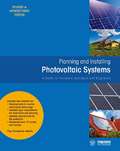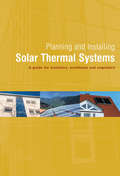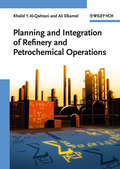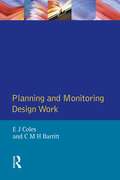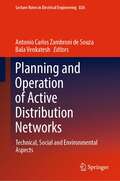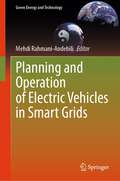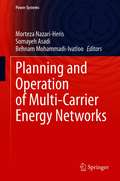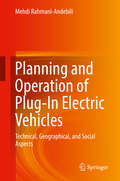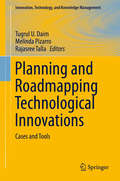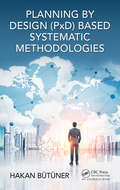- Table View
- List View
Planning & Planting Your Dwarf Fruit Orchard: Storey's Country Wisdom Bulletin A-133 (Storey Country Wisdom Bulletin)
by Editors of Garden Way PublishingSince 1973, Storey's Country Wisdom Bulletins have offered practical, hands-on instructions designed to help readers master dozens of country living skills quickly and easily. There are now more than 170 titles in this series, and their remarkable popularity reflects the common desire of country and city dwellers alike to cultivate personal independence in everyday life.
Planning Inclusive Yachts: A Novel Approach to Yacht Design (Design For Inclusion #1)
by Paolo FerrariThis book proposes a novel approach to the design of accessible and inclusive sailing yachts, inspired by the principles of “Design for All.” The goal is to allow anyone, including users with disabilities and individuals belonging to the weaker segments, to sail without barriers. Starting from an analysis of existing pleasure boats, the author identifies a series of factors limiting the accessibility or usability of external and internal spaces. In turn, he discusses the most suitable solutions to each. By proposing an extensive set of design solutions applicable to the confined spaces on yachts, and which comply with the relevant anthropometric and dimensional rules, the book offers a timely snapshot of the potential benefits and applicability of an inclusive approach to yacht design, setting a new reference standard for inclusive and accessible nautical design.
Planning Olympic Legacies: Transport Dreams and Urban Realities
by Eva Kassens-NoorWhen a city wins the right to hold the Olympics, one of the oft cited advantages to the region is the catalytic effect upon the urban and transport projects of the host cities. However, with unparalleled access to documents and records, Eva Kassens-Noor questions and challenges this fundamental assertion of host cities who claim to have used the Olympic Games as a way to move forward their urban agendas In fact, transport dreams to stage the "perfect games" of the International Olympic Committee and the governments of the host cities have lead to urban realities that significantly differ from the development path the city had set out to accomplish before winning the Olympic bid. Ultimately it is precisely the IOC’s influence – and the city’s foresight and sophistication (or lack thereof) in coping with it – that determines whether years after the Games there are legacies benefitting the former hosts. The text is supported by revealing interviews from lead host city planners and key documents, which highlight striking discrepancies between media broadcasts and the internal communications between the IOC and host city governments. It focuses on the inside story of the urban and transport change process undergone by four cities (Barcelona, Atlanta, Sydney, and Athens) that staged the Olympics and forecasts London and Rio de Janeiro’s urban trajectories. The final chapter advises cities on how to leverage the Olympic opportunity to advance their long-run urban strategic plans and interests while fulfilling the International Olympic Committee’s fundamental requirements. This is a uniquely positioned look at why Olympic cities have – or do not have – the transport and urban legacies they had wished for. The book will be of interest to planners, government agencies and those involved in organizing future Games.
Planning Production and Inventories in the Extended Enterprise: A State-of-the-Art Handbook, Volume 2
by Pınar Keskinocak Reha Uzsoy Karl G KempfIn two volumes, Planning Production and Inventories in the Extended Enterprise: A State of the Art Handbook examines production planning across the extended enterprise against a backdrop of important gaps between theory and practice. The early chapters describe the multifaceted nature of production planning problems and reveal many of the core complexities. The middle chapters describe recent research on theoretical techniques to manage these complexities. Accounts of production planning system currently in use in various industries are included in the later chapters. Throughout the two volumes there are suggestions on promising directions for future work focused on closing the gaps. Included in Volume 1 are papers on the Historical Foundations of Manufacturing Planning and Control; Advanced Planning and Scheduling Systems; Sustainable Product Development and Manufacturing; Uncertainty and Production Planning; Demand Forecasting; Production Capacity; Data in Production and Supply Chain Planning; Financial Uncertainty in SC Models; Field Based Research in Production Control; Collaborative SCM; Sequencing and Coordination in Outsourcing and Subcontracting Operations; Inventory Management; Pricing, Variety and Inventory Decisions for Substitutable Items; Perishable and Aging Inventories; Optimization Models of Production Planning Problems; Aggregate Modeling of Manufacturing Systems; Robust Stability Analysis of Decentralized Supply Chains; Simulation in Production Planning; and Simulation-Optimization in Support of Tactical and Strategic Enterprise Decisions. Included in Volume 2 are papers on Workload and Lead-Time Considerations under Uncertainty; Production Planning and Scheduling; Production Planning Effects on Dynamic Behavior of A Simple Supply Chain; Supply and Demand in Assemble-to-Order Supply Chains; Quantitative Risk Assessment in Supply Chains; A Practical Multi-Echelon Inventory Model with Semiconductor Application; Supplier Managed Inventory for Custom Items with Long Lead Times; Decentralized Supply Chain Formation; A Cooperative Game Approach to Procurement Network Formation; Flexible SC Contracts with Options; Build-to-Order Meets Global Sourcing for the Auto Industry; Practical Modeling in Automotive Production; Discrete Event Simulation Models; Diagnosing and Tuning a Statistical Forecasting System; Enterprise-Wide SC Planning in Semiconductor and Package Operations; Production Planning in Plastics; SC Execution Using Predictive Control; Production Scheduling in The Pharmaceutical Industry; Computerized Scheduling for Continuous Casting in Steelmaking; and Multi-Model Production Planning and Scheduling in an Industrial Environment.
Planning Sustainable and Resilient Food Systems: From Soil to Soil
by Julia FreedgoodCovid-19 was a canary in a mine. It exposed the vulnerabilities of 21st-century food systems but did not create them. Since then, the world has faced a “polycrisis:” a cluster of weather-related crop failures, war-induced food and energy shortages, and import dilemmas with compounding effects. Going forward, we need to plan for more sustainable and resilient food systems that improve environmental outcomes and address economic disparities. But food systems planning is a relatively new discipline and guidance is scarce. This book fills that gap.Where most food systems planning has focused on urban issues, this book takes a holistic view to include rural communities and production agriculture whose stewardship of the earth is so critical to public and environmental health, as well as to ensuring a varied and abundant food supply. Its goal is to inform planning practices and follow-up actions for a wide range of audiences—from professional planners, planning commissions, and boards to conservation districts and Cooperative Extension to the on-the-ground change-makers working to strengthen America’s food and farming systems. Embracing the fact that the U.S. is highly diverse in its people, places, and politics, the book lifts up principles and successful examples to help communities develop strategies based on their unique assets and the needs and preferences of their people.
Planning and Control of Expandable Multi-Terminal VSC-HVDC Transmission Systems (Springer Theses)
by Roni IrnawanThis book discusses novel methods for planning and coordinating converters when an existing point-to-point (PtP) HVDC link is expanded into a multi-terminal HVDC (MTDC) system. It demonstrates that expanding an existing PtP HVDC link is the best way to build an MTDC system, and is especially a better option than the build-from-scratch approach in cases where several voltage-sourced converter (VSC) HVDC links are already in operation. The book reports in detail on the approaches used to estimate the new steady-state operation limits of the expanded system and examines the factors influencing them, revealing new operation limits in the process. Further, the book explains how to coordinate the converters to stay within the limits after there has been a disturbance in the system. In closing, it describes the current DC grid control concept, including how to implement it in an MTDC system, and introduces a new DC grid control layer, the primary control interface (IFC).
Planning and Control of Maintenance Systems
by Salih O. Duffuaa A. RaoufAnalyzing maintenance as an integrated system with objectives, strategies and processes that need to be planned, designed, engineered, and controlled using statistical and optimization techniques, the theme of this book is the strategic holistic system approach for maintenance. This approach enables maintenance decision makers to view maintenance as a provider of a competitive edge not a necessary evil. Encompassing maintenance systems; maintenance strategic and capacity planning, planned and preventive maintenance, work measurements and standards, material (spares) control, maintenance operations and control, planning and scheduling, maintenance quality, training, and others, this book gives readers an understanding of the relevant methodology and how to apply it to real-world problems in industry. Each chapter includes a number exercises and is suitable as a textbook or a reference for a professionals and practitioners whilst being of interest to industrial engineering, mechanical engineering, electrical engineering, and industrial management students. It can also be used as a textbook for short courses on maintenance in industry. This text is the second edition of the book, which has four new chapters added and three chapters are revised substantially to reflect development in maintenance since the publication of the first edition. The new chapters cover reliability centered maintenance, total productive maintenance, e-maintenance and maintenance performance, productivity and continuous improvement.
Planning and Decision Making for Aerial Robots
by Yasmina Bestaoui SebbaneThis book provides an introduction to the emerging field of planning and decision making for aerial robots. An aerial robot is the ultimate form of Unmanned Aerial Vehicle, an aircraft endowed with built-in intelligence, requiring no direct human control and able to perform a specific task. It must be able to fly within a partially structured environment, to react and adapt to changing environmental conditions and to accommodate for the uncertainty that exists in the physical world. An aerial robot can be termed as a physical agent that exists and flies in the real 3D world, can sense its environment and act on it to achieve specific goals. So throughout this book, an aerial robot will also be termed as an agent. Fundamental problems in aerial robotics include the tasks of spatial motion, spatial sensing and spatial reasoning. Reasoning in complex environments represents a difficult problem. The issues specific to spatial reasoning are planning and decision making. Planning deals with the trajectory algorithmic development based on the available information, while decision making determines priorities and evaluates potential environmental uncertainties. The issues specific to planning and decision making for aerial robots in their environment are examined in this book and categorized as follows: motion planning, deterministic decision making, decision making under uncertainty and finally multi-robot planning. A variety of techniques are presented in this book, and a number of relevant case studies are examined. The topics considered in this book are multidisciplinary in nature and lie at the intersection of Robotics, Control Theory, Operational Research and Artificial Intelligence.
Planning and Design of Engineering Systems (Third Edition)
by Robert Warner Graeme Dandy Trevor Daniell Bernadette Foley<p>This newly updated book offers a comprehensive introduction to the scope and nature of engineering work, taking a rigorous but common sense approach to the solution of engineering problems. The text follows the planning, modelling and design phases of engineering projects through to implementation or construction, explaining the conceptual framework for undertaking projects, and then providing a range of techniques and tools for solutions. It focuses on engineering design and problem solving, but also involves economic, environmental, social and ethical considerations. <p>This third edition expands significantly on the economic evaluation of projects and also includes a new section on intractable problems and systems, involving a discussion of wicked problems and soft systems methodology as well as the approaches to software development. Further developments include an array of additional interest boxes, worked examples, problems and up-to date references. <p>Case studies and real-world examples are used to illustrate the role of the engineer and especially the methods employed in engineering practice. The examples are drawn particularly from the fields of civil and environmental engineering, but the approaches and techniques are more widely applicable to other branches of engineering. <p>The book is aimed at first-year engineering students, but contains material to suit more advanced undergraduates. It also functions as a professional handbook, covering some of the fundamentals of engineering planning and design in detail.</p>
Planning and Design of Engineering Systems, Second Edition
by David Walker Robert Warner Graeme Dandy Trevor DaniellProviding students with a commonsense approach to the solution of engineering problems and packed full of practical case studies to illustrate the role of the engineer, the type of work involved and the methodologies employed in engineering practice, this textbook is a comprehensive introduction to the scope and nature of engineering. It outlines a conceptual framework for undertaking engineering projects then provides a range of techniques and tools for solving the sorts of problems that commonly arise. Focusing in particular on civil engineering design, problem solving, and the range of techniques and tools it employs, the authors also explore: creativity and problem solving, social and environmental issues, management, communications and law, and ethics the planning, design, modelling and analysis phases and the implementation or construction phase. Designed specifically for introductory courses on undergraduate engineering programs, this extensively revised and extended second edition is an invaluable resource for all new engineering undergraduates as well as non-specialist readers who are seeking information on the nature of engineering work and how it is carried out.
Planning and Designing the IP Broadcast Facility: A New Puzzle to Solve
by Gary OlsonThe transition to computer-based technologies and file-based workflows is one of the most significant changes the broadcast and production industry has seen. Media is produced for multiple delivery platforms: Over the Air, Over the Top, large screen displays, cable, satellite, web, digital signage, tablets, and smartphones. These changes impact all aspects of creation, production, media management, technical operations, business processes, and distribution to end users. Of all the books and papers discussing storage mapping, packet transport, and compression algorithms, none puts all the pieces together and explains where these fit into the whole environment. Planning and Designing the IP Broadcast Facility is the first to provide a comprehensive understanding of the technology architecture, physical facility changes, and—most importantly—the new media management workflows and business processes to support the entire lifecycle of the IP broadcast facility from an engineering and workflow perspective. Key features: This beginning-to-end perspective gives you the necessary knowledge to make the decisions to implement a cost-effective file-based production and distribution system. The cohesive, big-picture viewpoint helps you identify the differences in a tape-based facility, then how to overcome the unique challenges of upgrading your plant. Case studies throughout the book serve as recommendations and examples of use, helping you weigh the pros and cons of various approaches.
Planning and Designing the IP Broadcast Facility: A New Puzzle to Solve
by Gary OlsonThis book provides a comprehensive understanding of the technology architecture, physical facility changes and – most importantly – the new media management workflows and business processes to support the entire lifecycle of the IP broadcast facility from an engineering and workflow perspective. Fully updated, this second edition covers the technological evolutions and changes in the media broadcast industry, including the new standards and specifications for live IP production, the SMPTE ST2110 suite of standards, the necessity of protecting against cyber threats and the expansion of cloud services in opening new possibilities. It provides users with the necessary information for planning, organizing, producing and distributing media for the modern broadcast facility. Key features of this text include: Strategies to implement a cost-effective live and file-based production and distribution system. A cohesive, big-picture viewpoint that helps you identify how to overcome the challenges of upgrading your plant. The impact live production is having on the evolution to IP. Case studies serve as recommendations and examples of use. New considerations in engineering and maintenance of IP and file-based systems. Those in the fields of TV, cable, IT engineering and broadcast engineering will find this book an invaluable resource, as will students learning how to set up modern broadcast facilities and the workflows of contemporary broadcasting.
Planning and Executing Credible Experiments: A Guidebook for Engineering, Science, Industrial Processes, Agriculture, and Business
by Robert J. Moffat Roy W. HenkCovers experiment planning, execution, analysis, and reporting This single-source resource guides readers in planning and conducting credible experiments for engineering, science, industrial processes, agriculture, and business. The text takes experimenters all the way through conducting a high-impact experiment, from initial conception, through execution of the experiment, to a defensible final report. It prepares the reader to anticipate the choices faced during each stage. Filled with real-world examples from engineering science and industry, Planning and Executing Credible Experiments: A Guidebook for Engineering, Science, Industrial Processes, Agriculture, and Business offers chapters that challenge experimenters at each stage of planning and execution and emphasizes uncertainty analysis as a design tool in addition to its role for reporting results. Tested over decades at Stanford University and internationally, the text employs two powerful, free, open-source software tools: GOSSET to optimize experiment design, and R for statistical computing and graphics. A website accompanies the text, providing additional resources and software downloads. A comprehensive guide to experiment planning, execution, and analysis Leads from initial conception, through the experiment’s launch, to final report Prepares the reader to anticipate the choices faced throughout an experiment Hones the motivating question Employs principles and techniques from Design of Experiments (DoE) Selects experiment designs to obtain the most information from fewer experimental runs Offers chapters that propose questions that an experimenter will need to ask and answer during each stage of planning and execution Demonstrates how uncertainty analysis guides and strengthens each stage Includes examples from real-life industrial experiments Accompanied by a website hosting open-source software Planning and Executing Credible Experiments is an excellent resource for graduates and senior undergraduates—as well as professionals—across a wide variety of engineering disciplines.
Planning and Installing Bioenergy Systems: A Guide for Installers, Architects and Engineers (Planning and Installing)
by German Solar Energy Society EcofysBioenergy is relied upon worldwide as a modern solution for local energy supply and waste managements. With clear technical details, data tables and illustrative pictures explaining the fundamentals of different bioenergy projects, this guide reviews the main technologies and offers relevant best-practice examples. Beginning with an overview of the technologies and types of systems available, the guide is packed with essential 'know-how' on anaerobic digestion, bio-fuel, small-scale ovens, large-scale boilers and gasifiers. Each technology is explained by examining the overall system and its components, planning, operation, maintenance, installation and economics. Information is given on both heat and combined heat and power. In addition, international legal framework and data on selected regional, national and international support programmes are provided. In short, this book describes the key features of different bioenergy technologies and offers professionals expert guidance for installation. It will be a cherished resource for engineers and architects alike who are working in new projects, farmers keen to explore this technology and practitioners or students with a specialized and practical interest in this field.
Planning and Installing Micro-Hydro Systems: A Guide for Designers, Installers and Engineers (Planning and Installing)
by Chris ElliottAn essential addition to the Earthscan Planning & Installing series, Planning and Installing Micro-Hydro Systems provides vital diagrams, pictures and tables detailing the planning and installing of a micro-hydro system, including information on the maintenance and economics once an installation is running. The book covers subjects such as measuring head and flow, ecological impacts, scheme layouts, practical advice, calculations and turbine choice. Archimedes screws are also covered in detail, as well as the main conventional choices relevant to small sites. Micro-hydro refers to hydropower systems with a power rating of 100kW or less. A 100kW system will produce 100 standard units of electricity in one hour. These systems have been popular in some sparsely populated or mountainous countries for a number of years, but now new technology, less stringent regulation of grid connected generators and standardised turbine designs are encouraging more widespread interest in micro-hydro in the developed world. The renewable energy sector is growing at a remarkable rate, and whilst much attention has so far focused on solar and wind technologies, Europe and elsewhere have great potential for generating power from small scale hydroelectric installations. This book is aimed at site owners, designers and consultants who are looking to develop schemes in the micro-hydro scale – 5 to 100kW – although the concepts are applicable to smaller and larger schemes.
Planning and Installing Photovoltaic Systems: A Guide for Installers, Architects and Engineers (Planning and Installing)
by Deutsche Gesellschaft für Sonnenenergie (DGS)New third edition of the bestselling manual from the German Solar Energy Society (DGS), showing you the essential steps to plan and install a solar photovoltaic system. With a global focus, it has been updated to include sections on new technology and concepts, new legislation and the current PV market. Updates cover: new developments in inverter and module technology market situation worldwide and outlook integration to the grid (voltage stabilization, frequency, remote control) new legal requirements for installation and planning operational costs for dismantling and recycling feed-in management new requirements for fire protection new requirements in Europe for electric waste (Waste Electrical and Electronic Equipment, WEEE) and the restriction of the use of certain hazardous substances (RoHS). Also providing information on current developments in system design, economic analysis, operation and maintenance of PV systems, as well as new software tools, hybrid and tracking systems. An essential manual for installers, engineers and architects, it details every subject necessary for successful project implementation, from the technical design to the legal and marketing issues of PV installation.
Planning and Installing Solar Thermal Systems: A Guide for Installers, Architects and Engineers (Planning and Installing)
by German Solar Energy Society (DGS)Solar thermal systems available today offer efficiency and reliability. They can be applied in different conditions to meet space- and water-heating requirements in the residential, commercial and industrial building sectors. The potential for this technology and the associated environmental benefits are significant. This fully updated edition of 2004's bestselling guide offers clear guidance on planning and installing a solar thermal system, crucial to the successful uptake of this technology. All major topics for successful project implementation are included. Beginning with resource assessment and an outline of core components, it details solar thermal system design, installation, operation and maintenance for single households, large systems, swimming pool heaters, solar air and solar cooling applications. Details on how to market solar thermal technologies, a review of relevant simulation tools and data on selected regional, national and international renewable energy programmes are also provided. In short, the book offers comprehensive guidance for professionals who wish to install solar thermal technology and is a highly valued resource for architects and engineers alike who are working on new projects, electricians, roofers and other installers, craftsmen undertaking vocational training and anyone with a specialized and practical interest in this field. Published with DGS
Planning and Integration of Refinery and Petrochemical Operations
by Ali Elkamel Khalid Y. Al-QahtaniClearly divided into three main sections, this practical book familiarizes readers with the area of planning in petroleum refining and petrochemical industry, while introducing several planning and modeling strategies encompassing single site refinery plants, multiple refinery networks, petrochemical networks, and refinery and petrochemical planning systems. It equally provides an insight into possible research directions and recommendations for the area of refinery and petrochemical planning. Furthermore, several appendices are included to explain the general background necessary, including stochastic programming, chance constraint programming, and robust optimization. For engineers and managers working in the petroleum industry as well as academic researchers in production, logistics, and supply chain management.
Planning and Monitoring Design Work (Chartered Institute of Building)
by E. J. Coles C.M.H BarrittWith the rise of "design and build" many more organisations are having to undertake design work; new project organisational structures are developing and many people are migrating into new roles. As a result of these changing times it is more important than ever that we understand that design work needs managed in a different way to many other construction operations. Planning and Monitoring of Design Work describes how to plan and control the progress of design work in the construction industry. It considers how the input of different design specialists should be integrated, from inception to site operations, to meet cost, time and quality objectives. The book provides a practical guide to the methodologies for the better planning of construction projects, and explains how planning and monitoring can help a construction organisation obtain good quality design information for tendering and construction purposes.
Planning and Operation of Active Distribution Networks: Technical, Social and Environmental Aspects (Lecture Notes in Electrical Engineering #826)
by Antonio Carlos Zambroni de Souza Bala VenkateshThis book offers a broad and detailed view about how traditional distribution systems are evolving smart/active systems. The reader will be able to share the view of a number of researchers directly involved in this field. For this sake, philosophical discussions are enriched by the presentation of theoretical and computational tools. A senior reader may incorporate some concepts not available during his/her graduation process, whereas new Engineers may have contact with some material that may be essential to his/her practice as professionals.
Planning and Operation of Electric Vehicles in Smart Grids (Green Energy and Technology)
by Mehdi Rahmani-AndebiliTransportation electrification, particularly using electric vehicles (EV), has been widely suggested to mitigate global warming and energy security issues due to their economic and environmental benefits. Environmentalists are advertising EV use, and governments are implementing financial incentives to expedite the transition from conventional vehicles to electric ones to achieve energy security and climate change mitigation goals. At the same time, EVs are becoming more affordable as their battery prices decrease. It has been predicted that EV sales will soon surpass gasoline and diesel vehicle sales. Therefore, EVs will be one of the significant electricity customers in the future. This fact hints that the uncontrolled charging and discharging of large numbers of EVs can put power systems at risk. Hence, optimal planning and operation of EVs is not only necessary but beneficial. This collection covers recent research advancements in the planning and operation of EVs in smart grids. A global group of researchers and scholars present innovative approaches while covering the theoretical and experimental aspects.
Planning and Operation of Multi-Carrier Energy Networks (Power Systems)
by Behnam Mohammadi-Ivatloo Morteza Nazari-Heris Somayeh AsadiThis book discusses the optimal design and operation of multi-carrier energy systems, providing a comprehensive review of existing systems as well as proposing new models. Chapters cover the theoretical background and application examples of interconnecting energy technologies such as combined heat and power plants, natural gas-fired power plants, power to gas technology, hydropower plants, and water desalination systems, taking into account the operational and technical constraints of each interconnecting element and the network constraint of each energy system. This book will be a valuable reference for power network and mechanical system professionals and engineers, electrical power engineering researchers and developers, and professionals from affiliated power system planning communities.Provides insight on the design and operation of multi-carrier energy systems;Covers both theoretical aspects and technical applications;Includes case studies to help apply concepts to real engineering situations.
Planning and Operation of Plug-In Electric Vehicles: Technical, Geographical, and Social Aspects
by Mehdi Rahmani-AndebiliThis book highlights the latest advancements in the planning and operation of plug-in electric vehicles (PEV). In-depth, the book presents essential planning and operation techniques to manage the PEV fleet and handle the related uncertainties associated with the drivers’ behavior. Several viewpoints are presented in the book, ranging from the local distribution companies to generation companies to the aggregators. Problems such as parking lot allocation and charging management are investigated, taking into consideration the technical, geographical, and social aspects in a smart grid infrastructure.Discusses the technical specifications of electrical distribution and generation systems;Models drivers’ behavior from the sociology and economic points of view;Considers the real geographical characteristics of area and driving routes in San Francisco, CA, US; Chicago, IL, US; and Tehran, Iran.
Planning and Roadmapping Technological Innovations
by Tugrul U. Daim Melinda Pizarro Rajasree TallaAcross industries, firms vary broadly on how they operate with respect to their Research & Development (R&D) activities. This volume presents a holistic approach to evaluating the critical elements of R&D management, including planning, organization, portfolio management, project management, and knowledge transfer--by assessing R&D management from different sectors. Featuring empirical research and in-depth case studies from industries as diverse as medical imaging, electric vehicles, and cyber security, the authors identify common features of successful R&D management, despite fundamental differences, such as company size, number of employees, industry sector, and the R&D budget. In particular, they consider the implications for decision making with respect to resource allocation and investments, such as site selection, purchasing, and cross-departmental communication.
Planning by Design (PxD)-Based Systematic Methodologies
by Hakan ButunerThe book shows how to use Planning by Design (PxD) for developing working models to any type of subject area. Section 1 describes the nature of planning in general, the formula of planning, the features that make it systematic, the essence of PxD, and developing and using the working model. Section 2 demonstrates personal application of creative planning to real life cases and practical working models on different subject areas. The book provides a general planning "master guide" that shows how to develop a working model of any definable subject matter. This objective will be accomplished by introducing the concepts, the process, and the methodology of PxD.
